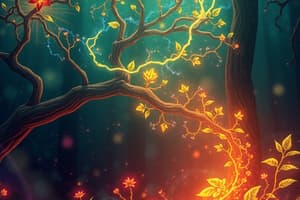Podcast
Questions and Answers
Which characteristic is not universally observed in all living organisms?
Which characteristic is not universally observed in all living organisms?
- Utilization of energy for metabolic processes.
- Response to environmental stimuli.
- Reproduction through sexual means. (correct)
- Maintenance of internal homeostasis.
Which cellular component is primarily responsible for generating ATP through cellular respiration?
Which cellular component is primarily responsible for generating ATP through cellular respiration?
- Mitochondrion (correct)
- Ribosome
- Endoplasmic reticulum
- Lysosome
What process describes the creation of RNA from a DNA template?
What process describes the creation of RNA from a DNA template?
- Transformation
- Translation
- Transcription (correct)
- Replication
In evolutionary biology, what distinguishes analogous structures from homologous structures?
In evolutionary biology, what distinguishes analogous structures from homologous structures?
Which of the following is an example of a community in an ecological context?
Which of the following is an example of a community in an ecological context?
Which organ system is primarily responsible for regulating body functions through the use of hormones?
Which organ system is primarily responsible for regulating body functions through the use of hormones?
What is the significance of the central dogma of molecular biology?
What is the significance of the central dogma of molecular biology?
Which of the following is a key criterion in defining a biome?
Which of the following is a key criterion in defining a biome?
What is the role of decomposers in an ecosystem?
What is the role of decomposers in an ecosystem?
Which branch of biology focuses on the study of heredity and variation of inherited characteristics?
Which branch of biology focuses on the study of heredity and variation of inherited characteristics?
Flashcards
Biology
Biology
The scientific study of life.
Cell Theory
Cell Theory
Cells are the basic unit of life.
Evolution
Evolution
Evolution explains the unity and diversity of life.
Homeostasis
Homeostasis
Signup and view all the flashcards
Microbiology
Microbiology
Signup and view all the flashcards
Genetics
Genetics
Signup and view all the flashcards
Evolution
Evolution
Signup and view all the flashcards
Ecosystem
Ecosystem
Signup and view all the flashcards
Producers (Autotrophs)
Producers (Autotrophs)
Signup and view all the flashcards
Homeostasis
Homeostasis
Signup and view all the flashcards
Study Notes
- Biology is the scientific study of life.
Core Principles of Biology
- Biology recognizes that cells are the basic unit of life.
- Genes are the basic unit of heredity.
- Evolution explains the unity and diversity of life.
- Living organisms maintain homeostasis to survive.
Branches of Biology
- Biochemistry studies the chemical processes within and relating to living organisms.
- Microbiology studies microorganisms, such as bacteria, viruses, fungi, and protozoa.
- Botany examines plants, including their physiology, structure, genetics, ecology, distribution, classification, and economic importance.
- Zoology involves the study of animals, including their physiology, anatomy, behavior, genetics, ecology, evolution, and classification.
- Genetics explores heredity and variation of inherited characteristics.
- Ecology studies the interactions of organisms with each other and their environment.
- Evolutionary biology studies the evolutionary processes that produced the diversity of life on Earth.
- Physiology examines the functions and mechanisms in a living system.
- Anatomy studies the structure of organisms and their parts.
- Molecular biology studies the molecular basis of biological activity between biomolecules in a cell.
- Marine biology studies marine organisms and marine life.
Characteristics of Life
- Living organisms exhibit organization, meaning they contain complex structural arrangements.
- Living organisms maintain homeostasis, which involves regulating internal conditions to keep them relatively stable.
- Living organisms reproduce, creating new organisms either sexually or asexually.
- Living organisms grow and develop, increasing in size and complexity.
- Living organisms use energy for various processes, such as metabolism and movement.
- Living organisms respond to stimuli from their environment.
- Living organisms adapt and evolve to better suit their environment over time.
Cell Biology
- The cell theory states that all living organisms are composed of cells, the cell is the basic unit of life, and cells arise from pre-existing cells.
- Cells are broadly classified as prokaryotic or eukaryotic.
- Prokaryotic cells lack a nucleus and other membrane-bound organelles.
- Eukaryotic cells possess a nucleus and other membrane-bound organelles.
- Key cell structures include the plasma membrane, nucleus, cytoplasm, ribosomes, mitochondria, endoplasmic reticulum, Golgi apparatus, lysosomes, and vacuoles.
- The plasma membrane controls the movement of substances into and out of the cell.
- The nucleus contains the cell's genetic material (DNA) and controls cell activities.
- Ribosomes are responsible for protein synthesis.
- Mitochondria are the powerhouses of the cell, carrying out cellular respiration to produce energy (ATP).
- The endoplasmic reticulum (ER) is involved in protein and lipid synthesis.
- The Golgi apparatus processes and packages proteins and lipids.
- Lysosomes contain enzymes for breaking down cellular waste and debris.
Genetics
- Genes are segments of DNA that code for specific traits and are passed from parents to offspring.
- DNA (deoxyribonucleic acid) is the genetic material that contains the instructions for building and maintaining organisms.
- DNA is a double-stranded helix made of nucleotides, each containing a sugar, a phosphate group, and a nitrogenous base (adenine, guanine, cytosine, or thymine).
- RNA (ribonucleic acid) is a single-stranded molecule involved in protein synthesis.
- The central dogma of molecular biology describes the flow of genetic information from DNA to RNA to protein.
- Transcription is the process of copying DNA into RNA.
- Translation is the process of using RNA to synthesize proteins.
- Mutations are changes in the DNA sequence that can result in altered traits.
- Mendelian genetics studies the inheritance of traits through generations.
- Genomics is the study of entire genomes, including genes and their functions.
Evolution
- Evolution is the change in the heritable characteristics of biological populations over successive generations.
- Natural selection is a mechanism of evolution in which organisms with traits better suited to their environment are more likely to survive and reproduce.
- Adaptation is the process by which organisms evolve traits that enhance their survival and reproduction in a specific environment.
- Evidence for evolution includes the fossil record, comparative anatomy, comparative embryology, molecular biology, and biogeography.
- The fossil record provides evidence of past life forms and their transitions over time.
- Homologous structures are similar structures in different organisms that share a common ancestry.
- Analogous structures are structures in different organisms that have similar functions but different evolutionary origins.
- Comparative embryology reveals similarities in the development of different organisms.
- Molecular biology provides evidence for evolution through the similarities and differences in DNA and protein sequences.
- Speciation is the process by which new species arise.
Ecology
- Ecology is the study of the interactions of organisms with each other and their environment.
- An ecosystem is a community of living organisms (biotic factors) interacting with their physical environment (abiotic factors).
- Populations are groups of individuals of the same species living in the same area.
- Communities are assemblages of different populations that live together in a defined area.
- Biomes are large geographic areas characterized by specific climate conditions, animal populations, and plant populations.
- The biosphere is the global sum of all ecosystems.
- Trophic levels describe the position of an organism in a food chain or food web.
- Producers (autotrophs) are organisms that produce their own food through photosynthesis or chemosynthesis.
- Consumers (heterotrophs) are organisms that obtain energy by consuming other organisms.
- Decomposers break down dead organic matter, returning nutrients to the ecosystem.
- Food chains illustrate the flow of energy from one organism to another.
- Food webs are interconnected food chains that represent the complex feeding relationships in an ecosystem.
- Biogeochemical cycles describe the movement of essential elements (e.g., carbon, nitrogen, water) through ecosystems.
- Population ecology studies the factors that influence population size, density, and distribution.
- Community ecology examines the interactions between different species in a community.
Physiology
- Physiology is the study of the functions and mechanisms in a living system.
- Homeostasis is the maintenance of a stable internal environment in the body.
- The major organ systems in animals include the nervous system, endocrine system, cardiovascular system, respiratory system, digestive system, excretory system, immune system, skeletal system, and muscular system.
- The nervous system controls and coordinates body functions through electrical and chemical signals.
- The endocrine system regulates body functions through hormones.
- The cardiovascular system transports blood, oxygen, and nutrients throughout the body.
- The respiratory system facilitates gas exchange (oxygen and carbon dioxide).
- The digestive system breaks down food and absorbs nutrients.
- The excretory system removes waste products from the body.
- The immune system defends the body against pathogens and diseases.
- The skeletal system provides support and structure to the body.
- The muscular system enables movement.
- Plant physiology studies the functions and processes in plants, including photosynthesis, transpiration, and nutrient uptake.
Studying That Suits You
Use AI to generate personalized quizzes and flashcards to suit your learning preferences.




